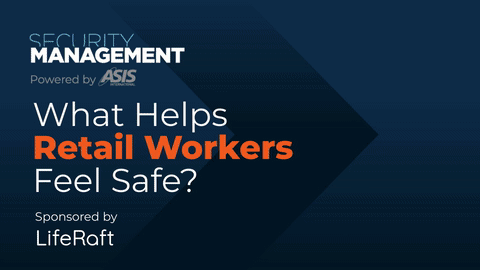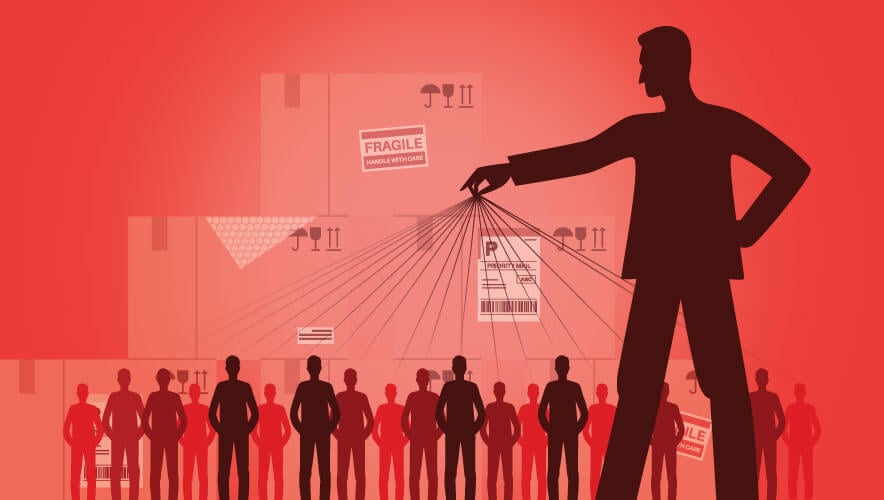Soft Skills Pay Off for Retailers Creating Safer Workplaces
At least 30 hooded and masked people rushed into a Nordstrom store in the Canoga Park area of Los Angeles, California, in August 2023, snatching up and fleeing with an estimated $60,000 to $100,000 in merchandise before police could arrive.
Video footage of the attack—a style colloquially known as a smash-and-grab or a flash rob—showed the thieves grabbing any available merchandise, ripping off security devices, and knocking down shelves and displays. When a security guard tried to confront the thieves, they responded by blasting him with bear spray.
If this scenario sounds familiar, it’s not only because smash-and-grab robberies have frequently appeared in the news during the past few years. It’s also because in November 2021 a group of five robbed that same Nordstrom, grabbing high-end purses and attacking a responding security guard with bear spray. The group stole merchandise worth an estimated $25,000.
But these coordinated attacks have not been limited to clothing or luxury stores.
In Denver, Colorado, almost two dozen people were arrested and charged in December 2023 with participating in one of two organized retail crime (ORC) groups. The individuals allegedly stole vehicles that were then used to help burgle more than 40 marijuana dispensaries and other businesses in the metro area between September 2022 and November 2023.
Also in December, prosecutors indicted twelve people in connection with an ORC group committing smash-and-grabs in Memphis, Tennessee. The charges were part of a larger law enforcement investigation, Operation Broken Bottles, which looked into violent or destructive thefts, some targeting the same businesses multiple times.
In British Columbia, a spate of thefts from violent shoplifters prompted law enforcement in Vancouver and Kelowna to conduct plainclothes patrols through retail stores, arrest hundreds of people, seize weapons, and recover more than $110,000 in stolen merchandise.
In the National Retail Federation’s 2023 Retail Security Survey, 88 percent of responding retail and security professionals said that shoplifters have become more aggressive and violent compared to the previous year. Two-thirds (67 percent) of respondents said they perceived more violence and aggression from ORC thieves compared to 2022.
And while ORC groups—which are defined as at least two people engaged in attempts to illegally secure retail merchandise or other valuable goods through theft or fraud as part of a criminal enterprise—are having a moment in the limelight, they’re not the only recent source of violence stores.
“We are sadly a very polarized country, and that polarization is seeping out of our personal lives and into the workplace,” says Sam Lichtenstein, director of analysis at RANE Network, a risk intelligence company. Lichtenstein adds that the upcoming U.S. presidential election, along with other social dynamics around contentious issues, will further inflame attitudes and increase workplace risks.
“This is not a unique problem to the United States by any means—workplace violence is sadly seen truly the world over,” Lichtenstein says. “But we have all these heightened social pressures and political rhetoric that are coming at you every day and will only get more intense as the campaign develops.”
Beyond societal or political tensions generated by what’s expected to be a contentious election season, retailers must consider a wide range of threats to employee and store safety while maintaining a welcoming environment for customers.
“We are very blessed to be a very diverse society, but that also means that in the workplace we have people with incredibly divergent views. Inevitably, some of those differences are going to come out,” Lichtenstein says.
Active shooters, frustrated shoppers, and verbally or physically abusive customers in retail sites may make store staff feel unsafe and on edge. Difficult or volatile customers usually fall along a spectrum, ranging from merely disgruntled to truly displeased and unappeasable to someone who is abusive or violent and cannot be de-escalated, according to Khris Hamlin, vice president of asset protection for the Retail Industry Leaders Association (RILA).
During the COVID-19 pandemic, retail workers often found themselves receiving the brunt of customers’ frustrations due to stay-home orders, mask mandates, vaccine policies, and other red-button issues that arose. Although the virus is now less rampant, virulent, and fatal than in 2020 and 2021, retail floor workers are still subject to someone walking in and taking out his or her frustration in their workplace.
“We’ve seen that shift, even after COVID-19, where people are a little bit edgier at times,” Hamlin says.
There are other reasons why a violent incident can occur in a retail location, perhaps involving someone suffering from a mental health crisis, a person involved in a violent or abusive domestic or intimate relationship, or an employee who is disgruntled.
Lichtenstein adds that pre-existing issues can be further stressed by environments with heightened tensions. For example, current armed conflicts between Russia and Ukraine, and in the Middle East, alongside lingering pandemic stress, may create a sense of unsettlement, as well as normalize incendiary or violent rhetoric used on social media and by mainstream media.
“The tragic good news is that most of the time, violent rhetoric stays just that….It doesn’t lead someone to commit violence,” Lichtenstein says. However, he adds, there are times when such speech gains traction in media and has a greater impact on the public, increasing stress and tension, inevitably affecting the listeners.
Although broader social, political, and international issues might not directly impact workplace safety, they can contribute to a person’s overall sense of tension and safety, including in retail environments.
Committing to Non-Violence
Some U.S. retailers already encourage non-security personnel—such as cashiers, sales associates, and shelf stockers—to not confront thieves or shoplifters, according to Hamlin. When these employees confront or try to apprehend someone who has entered the store with the intention of stealing merchandise or otherwise acting against the store, violence can occur. The resulting workplace violence, injuries, or even deaths can have wide-reaching impacts on the retailer, staff, and customers.
In The State of Retail Worker Safety 2023 Survey and Report, published by Motorola Solutions, more than half of the survey respondents reported an increase in petty theft, plus a one-third increase in hostile customer interactions on a store’s premises in 2023. These increases mean “it’s understandable that nearly two out of three (61 percent) retail workers and managers reported they are at least somewhat concerned for their personal safety,” according to the report.
Hamlin explains that in recent years, “employees of retailers are very passionate about what they do in the retail setting. So, when they see individuals—especially if it’s a habitual person that constantly comes back to the store and is stealing product—those [employees] will get agitated and want to confront them.”
But those confrontations mean that—regardless of their passion for the job—if an employee is not properly trained or competent in physical confrontation, he or she is at risk of injuring themselves or others. Hamlin says that RILA’s members tell their non-security employees to avoid physical altercations.
With or without an incident of violence, if employees feel at risk while at work, they are less likely to be productive or remain in the workplace. Employers may also have trouble hiring new staff if their stores are perceived to be unsafe.
Like with any security issue, companies must also consider the impact an incident has on its brand reputation or the potential for a liability suit. In decades past, Lichtenstein says evidence of an event may have been limited to internal surveillance footage or, if egregious enough, a report with law enforcement or coverage by a news outlet. Changes in government mandates (such as the General Duty Clause set by the U.S. Occupational Safety and Health Administration, or California’s new law requiring employers to design, implement, and maintain workplace violence prevention plans—as well as maintain records of incidents), a desire for greater transparency, and the Internet have shifted and eroded retailers’ control over the publication of a violent incident.
Beyond complying with state and federal mandates on reporting these events, social media has greatly changed the amount of video footage available of an event.
“It means that it’s much harder to hide, and it’s much easier to get these stories out there,” Lichtenstein says. “Now anyone with a smartphone that’s nearby in an instant can film it, post it online, and it can be picked up by mainstream media.”
Cultural shifts among consumers and businesses have also prompted brands to become more transparent in their activities and policies. This could include measures to let the public know the retailer can be trusted to create a safe environment for shoppers and employees, as well as procedures to report unsafe work conditions to foster support for employees. One of the benefits of transparency for companies is that talented employees will want to work there, according to Lichtenstein.
And by encouraging nonconfrontational engagement with customers through the sharing of knowledge and tools on mitigating volatile situations, employees can see that a retailer is invested in their safety, Hamlin points out.
Avoiding the Problem (Customer)
When it comes to training employees—whether they are part of an asset protection (AP) or loss prevention (LP) team, or a member of the sales and customer service team—preparing them to deal with violent situations by using nonconfrontation involves several soft skills.
Communicate effectively. De-escalating volatile situations starts with communication skills, which can help in understanding and then talking down a challenging customer. The overall goal in this stage is to calm the person down and bring him or her to a more reasonable interaction, Lichtenstein says.
For salesfloor associates, framing a conversation around collaboration or finding a solution to appease the customer is another tactic that can de-escalate a volatile shopper into a satisfied one.
Communication skills have broad benefits, helping sales associates communicate and provide customer service to shoppers who may enter a store in an aggressive mood.
“We need to understand and provide some guidance to minimize misunderstanding and create a baseline respect for one another,” Lichtenstein says.
Maintaining situational awareness can also help staff understand if the interaction becomes unsafe. Hamlin says RILA members are “teaching their asset protection teams that when it reaches that threshold, no amount of merchandise is worth somebody’s life.”
Once an employee realizes an incident cannot be de-escalated, their training tells them to back away, drop the issue, and allow the thief to leave the store.
Collect evidence. Thieves—whether opportunistic or part of a larger criminal effort—often view retail theft through the lens of low risk and high reward. As a result of this perception, there has been an increase in thieves returning to the scenes of their earlier crimes.
“What we’re seeing is the most interesting thing from all my time in asset protection,” says Hamlin, who has more than 25 years of retail experience. “Those individuals will come back. …If they get away with it today, and they see that it was easy for them to get away, they will continue to try over and over again, until finally they get caught. And sometimes that doesn’t even stop them.”
Retailers think this behavior may be due to thieves’ awareness about local thresholds in what amount of stolen merchandise qualifies for a felony charge instead of a misdemeanor, making thieves careful to remain below the threshold dollar amount. Some legislators have proposed increasing those thresholds for a variety of reasons, such as mitigating overcrowding prison populations, taking inflation into consideration, or attempting not to overly penalize someone who just made a mistake.
In 2010, California, Illinois, New Hampshire, South Carolina, and Utah increased their felony thresholds—California from $400 to $950, Illinois from $300 to $500, New Hampshire from $500 to $1,000, South Carolina from $1,000 to $2,000, and Utah from $1,000 to $1,500. However, recent violent or brazen thefts in San Francisco have retailers and the media at least partly blaming the raised limit for the crimes.
Thieves’ attitudes—knowing they can return to a store and steal seemingly without consequence—presents a risk that these actions may escalate into higher or more violent crimes.
“Retailers are in an impossible spot,” says Blake Lewkowitz, director of enterprise marketing and partnerships for Axon. “How do you stop somebody who is stealing your stuff? How do you take a step back when there’s a smash-and-grab situation? …The second you go hands-on in some situations, it’ll escalate and will cause issues.”
When dealing with a repeat offender targeting the same store or others nearby, AP/LP officers may find it useful to have evidence of previous crimes and other necessary documents and information already filed with law enforcement, Hamlin says. This preparation means that if an offender returns, an AP/LP officer can either directly engage the thief or ask law enforcement to intervene and increase the chances of a safe and successful apprehension.
Leverage body language. Another skill that proves immediately useful for staff engaged with a difficult customer or visitor is an awareness of personal space. “It has a real psychological component to it,” Lichtenstein says.
This requires a balancing act between standing close enough to a customer that the individual knows the employee is actively engaged but standing far enough away to avoid escalating the situation.
Lichtenstein also points out other soft skills that can benefit employees and their companies in the long run, including conflict resolution, active listening, and empathy.
Beyond training for an agitated or potentially violent customer or shoplifter, retailers should also include training that supports mitigating or resolving internal issues. From day one, employees should be aware of the company’s chain of command and multiple channels for reporting interactions with a difficult or aggressive person—whether it is a customer or coworker—and empowered to use these resources.
Not reporting instances of violent customers in the store may make it more likely that those customers will return and behave similarly in the future, Lichtenstein says.
Regardless of which skills, policies, and tools a retailer makes available to employees, companies need to extend training beyond onboarding. Hamlin recommends hosting quarterly or seasonal training refresher sessions for employee retention.
Other support tools for employees can come in the form of post-incident services, such as making crisis or grief counselors available after a traumatic event, and debriefing sessions that let employees know that the company wants to understand, analyze, and learn from the event to help prevent or mitigate it in the future.
The Litmus Test
As most security professionals know, trying to quantify something that didn’t happen can be tricky. This includes analyzing and measuring the success of de-escalation training.
Lichtenstein recommends analyzing reported scenarios, comparing potential incidents that did not escalate to those that did become violent.
Another method would be to compare data from different store branches—specifically ones where store employees are trained versus those with untrained employees, according to Hamlin. Ideally, the data would include the number of aggressive incidents or de-escalated incidents across multiple years.
Feedback from frontline employees, perhaps through anonymous surveys, would also be valuable, giving retailers insight into whether workers find value in the training.
Sara Mosqueda is associate editor for Security Management. Connect with her on LinkedIn or on X, @XimenaWrites.













